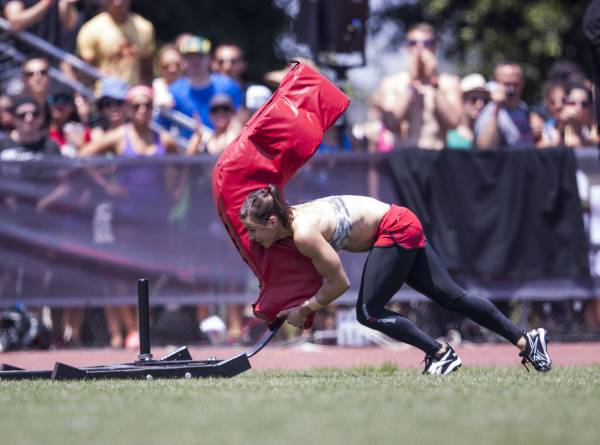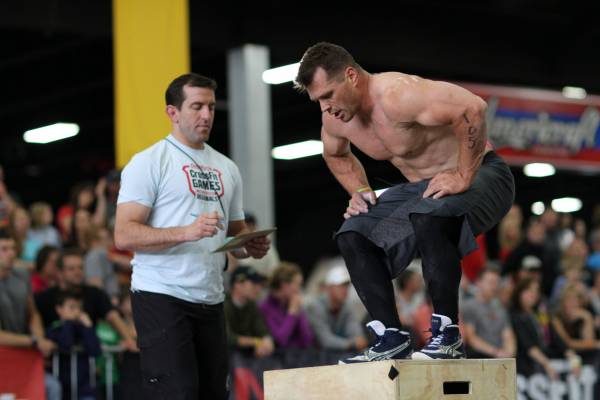Julie Foucher tore her Achilles tendon doing box jumps at the CrossFit Central Regionals.
Now, before everyone cocks their weapons: this is not that article. This article is about the conversation. The conversation that some seem unwilling to have and that others feel is long overdue.
Foucher finished first at the 2014 Central East Regionals.
The Reaction
Within minutes of Julie’s injury, there were already social media posts hitting the airwaves. Most of those were thoughts and prayers, well wishes, and expressions of shock and dismay that one of the best, most gracious, and by all accounts nicest competitor in the field had suffered a catastrophic injury on the eve of qualifying for the CrossFit Games. This, her last bid for the Games as her medical career is about to get underway.
“People immediately locked arms with their red-rover teammates, either on the side of ‘box jumps must end once and for all’ or ‘injuries happen in sports, get over it.'”
There were also arguments on social media. People immediately locked arms with their red-rover teammates, either on the side of “box jumps must end once and for all” or “injuries happen in sports, get over it.” Without delving too much into the nitty-gritty of every comment, this is a sampler:
- “Injuries happen, it’s a part of all sport, even at the top. To say that you know with certainty why it happened is arrogant and overstepping.”
- “The bottom line is she got hurt doing a movement that could have easily been redefined to mandate a stop on the ground to improve athlete safety. There were enough injuries in past years to warrant such a change, and if anything it would only make the WOD harder.”
- “This is one injury to a top athlete this happens all the time in all other sports we don’t need a major change here.”
- “The BJ is equally effective if you mandate a pause on the ground to virtually eliminate risk of Achilles ruptures. I don’t care if they hop down or step down, as long as they don’t rebound off the floor.”
It goes on. And, I suspect, is continuing to go on in other corners of the web, on blogs, Facebook, Twitter, Instagram, and Reddit. And this is where the argument usually ends up:
This argument is so intensely frustrating for CrossFitters because it’s a standard that doesn’t get applied to any other sport. When Kobe tears his ACL, it’s part of the game. When every other pitcher, including thousands of high school pitchers, are getting Tommy John it’s part of the game…When Julie Foucher tears her Achilles it’s a sport that’s inherently unsafe?

Julie Foucher finished second at the 2012 CrossFit Games and third in 2014.
Yes, Injuries Happen
Every sport carries with it the risk of injury. But this is an axiom from which we should start the conversation, not end it. To merely write off the incident, any incident, as “part of the game” and “she knew the risks” is to concede that safety, improvement, and evolution are not important concepts. It renders the athlete as subject to the whimsy of the governing body and event organizers, willing participants in their own modern-day gladiator games.
“To merely write off the incident, any incident, as “part of the game” and “she knew the risks” is to concede that safety, improvement, and evolution are not important concepts.”
Of course, injuries are a part of sports. Of course, athletes know the risks. Of course, you can just as easily snap an Achilles playing a game of pick-up basketball or hopping off the counter after grabbing a hard-to-reach piece of Tupperware. So, my question is this: “So what?”
What’s the Solution?
Does the fact that injuries happen mean the Games organizers and programmers should stop innovating when it comes to safety? No. Does it mean we shouldn’t have the conversation? God forbid, anyone actually feels that way. Does it mean box jumps should go away? Not necessarily, but I don’t know.
You would think that after a number of similar Achilles-related injuries over a period of time – starting most famously during Open 11.2, then Kate Rawlings, then Cheryl Brost at the 2013 Regionals, Kristine Andali, and now Julie Foucher – that, despite that instinctual urge for those at the top and those of us in the trenches to say, “It’s one in a million. Get over it,” that we might reach down deep and say something different. Something like, “Let’s examine this whole box-jump issue.”
“The conversation should be ongoing. And the worldwide community of CrossFitters should be participating in – not discouraged from – having that conversation.”
Perhaps the box jumps themselves are not the issue, but rather the sequence in which they arrived. Is it possible a combination of Achilles-stressing movements that began with front-foot loaded running through double unders and finally to 100 box jumps is to blame? Would a different sequence or a different rep scheme have made a difference? Maybe yes. Maybe no.
But at least, let’s ask.
Is it possible that the box jump over is to blame – the combination of torque and rebound?
Let’s ask.

Would a different box jump sequence have made a difference? Maybe yes. Maybe no. But at least, let’s ask.
We Need Conversation
The conversation should be ongoing. And the worldwide community of CrossFitters should be participating in – not discouraged from – having that conversation.
What some may dismiss as armchair quarterbacking can often serve a much more vital function as a grassroots source of chatter. Chatter, in digital parlance, is the collective voice of the masses expressed through social media, blogs, and elsewhere that makes up this Borg ship we call the CrossFit community.
“Let the discussion happen, and see which side of the discussion percolates to the top as the new paradigm. At that point, perhaps the community will demand change.”
Chatter can be a powerful force. Just ask the ALS Foundation or the Red Cross. Just look around at CrossFit in general and ask yourself why 99.9% of gyms step down from their box jumps today as opposed to rebounding in 2011. Chatter. It’s the conversation.
I am not suggesting that you demand change in the case of rebounding box jumps at the Regionals level. What I am suggesting is that you talk about it. Let the discussion happen, and see which side of the discussion percolates to the top as the new paradigm. At that point, perhaps the community will demand change. But for now, talk about it, bearing in mind that drawing a line in the sand does not constitute discussion.
“Injuries happen in sports” is not the end of the discussion. It should be the beginning. We’d love to hear your thoughts.
More Like This:
- The Risk of Injury in Competition and How You Can Protect Yourself
- Glassman vs. OCT: CrossFit HQ and the Kevin Ogar Tragedy
- Is CrossFit Dangerous? We May Never Know
- New on Pulse Beat Fit Today
Photos 1 and 3 ©2012 CrossFit, Inc. Used with permission from CrossFit, Inc.
Photo 2 ©2014 CrossFit, Inc. Used with permission from CrossFit, Inc.






